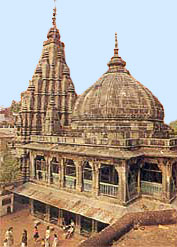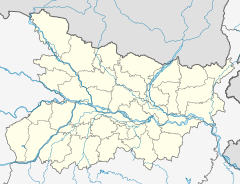Vishnupad Temple, Gaya
| Vishnupada Temple | |
|---|---|
 | |
| Religion | |
| Affiliation | Hinduism |
| District | Gaya district |
| Deity | Vishnu |
| Location | |
| Location | Gaya |
| State | Bihar |
| Country | India |
| Geographic coordinates | 24°36′37″N 85°0′33″E / 24.61028°N 85.00917°E |
| Architecture | |
| Type | Shikhara |
| Creator | rebuilt by Queen Ahilya Bai Holkar of Indore |
| Completed | rebuilt 1787 |
Vishnupad Temple (Sanskrit: विष्णुपद मंदिर, IAST: Viṣṇupada Mandira; lit. 'temple of Vishnu's feet') is a Hindu temple dedicated to Vishnu[1] in Gaya, Bihar, India, located on the banks of Phalgu river.[2] The temple is believed to be built upon the site where Vishnu had purportedly killed the demon Gayasura or pinned him underground. The temple features a 40-cm footprint purported to be of Vishnu incised into a block of basalt, known as Dharmasila which was retained when the deity stepped on Gayasura's chest before pinning him underground.
Atop the structure is a 50-kilo gold flag, donated by a devotee, Gayapal Panda Bal Govind Sen.[3]
The Vishnupad temple is the center for Shraddha rites in Gaya.[4]
The Brahma Kalpit Brahmins, who are also known as Gayawal Brahmins or Gayawal Tirth Purohit or Pandas of Gaya are the traditional priests of the temple from the ancient times.[5] The legendary saints Madhvacharya, Chaitanya Mahaprabhu, Vallabhacharya have visited this shrine.[6]
Legend

Once a demon known as Gayasura, did a heavy penance and sought a boon that whoever sees him should attain salvation (Moksham). Since salvation is achieved through being righteous in one's lifetime, people started obtaining it easily. To prevent immoral people from attaining salvation Vishnu asked Gayasura to go beneath the earth and did so by placing his right foot on asura's head. After pushing Gayasura below the surface of earth, Vishnu's foot print remained on the surface that we see even today. The footprint consists of nine different symbols including Shankam, Chakram and Gadham. These are believed to be weapons of the lord. Gayasura now pushed into earth pleaded for food. Vishnu gave him a boon that every day, someone will offer him food. Whoever does so, their souls will reach heaven. The day Gayasura doesn't get food, it is believed that he will come out. Every day, one or the other from different parts of India will pray for welfare of his departed and offer food, feeding Gayasura.[7]
The Dharmshila, a sacred stone believed to mark the exact place where Vishnu’s foot first touched the earth[8], is closely associated with this legend. Worshiped by devotees, it is considered a place of peace and prosperity. People from different parts of India continue to pray for the welfare of their departed souls, offering food to Gayasura to ensure that he remains beneath the earth and their souls reach heaven.
History and location

The construction date of temple is unknown and it is believed that Rama along with Sita had visited this place. The present day structure was rebuilt by Devi Ahilya Bai Holkar, the ruler of Indore, in 1787, on the banks of the Falgu river.[9] Ahilyabai Holkar had crafted the temple, sent her officers to inspect and find the best stone for the temple in whole region, and they finally found munger black stone as the best choice in Jaynagar. Since there was no proper road and the mountains were very far from Gaya, the officers found another mountain where they can carve and easily bring the stone to Gaya the place was near Bathani (a small village in Gaya district). The officers brought the craftsmen from Rajasthan. They started carving the temple in Patharkatti (a village and also a tourist place in Bihar). The final temple was assembled in Gaya near Vishnupad temple site. After the completing the construction of temple many craftsmen returned to their native places, but some of them settled-down in Pattharkatti village itself. Bihar government has marked this place as one of the prominent tourist spots of Bihar.[10] The 1000 stone steps leading to the top of the Brahmajuni hill on southwest of the Vishnupad mandir gives the view of Gaya city and the Vishnupad temple, which is a tourist spot. There are also many small temples near this temple.[11]
Architecture
This is believed that the temple was built with the footprints of Vishnu in the centre. In Hinduism, this footprint marks the act of Vishnu subduing Gayasur by placing his foot on his chest. Inside the Vishnupad Mandir, the 40 cm long footprint of Vishnu is imprinted in solid rock and surrounded by a silver plated basin. The height of this temple is 30 meters and it a has 8 rows of beautifully carved pillars which support the pavilion. The temple is built of large gray granite blocks jointed with iron clamps. The octagonal shrine faces east. Its pyramidal tower rises up a 100 feet. The tower has sloping sides with alternately indented and plain sections. The sections are set at an angle to create a series of peaks joined at the top.[12] Within the temple stands the immortal banyan tree Akshayavat where the final rituals for the dead takes place.[13] On top of the temple is a gold flag weighing approximately 51 kg. Inside the temple is a (Garbhagriha) a silver-coated hexagon railing also known as (pahal).
See also
References
- ^ Kulshreshtha 2017, p. 167.
- ^ Davidson & Gitlitz 2002, p. 194.
- ^ Singh 1978, p. 16.
- ^ Asher 2008, p. 89.
- ^ Singh 1978, p. 14.
- ^ Singh 1978, p. 15.
- ^ Bhoothalingam 2016, pp. 92–93.
- ^ "Gayasur Story - Gaya Vishnupad Temple Story - Pranah". pranah.site. Retrieved 2 December 2024.
- ^ "Vishnupad Temple". Times of India. 13 July 2016.
- ^ Martin 2012, pp. 62–64.
- ^ Boda 1994, p. 278.
- ^ Singh 2009, p. 96.
- ^ Varma 2005, p. 206.
Bibliography
- Singh, Kamaldeo Narain (1978). Urban Development in India. Abhinav Publications. ISBN 9788170170808.
- Asher, Frederick M. (2008). Bodh Gaya: Monumental Legacy. Oxford University Press. ISBN 9780195693140.
- Davidson, Linda Kay; Gitlitz, David Martin (2002). Pilgrimage: From the Ganges to Graceland : an Encyclopedia, Volume 1. ABC-CLIO. ISBN 9781576070048.
- Kulshreshtha, Salila (2017). From Temple to Museum: Colonial Collections and Umā Maheśvara Icons in the Middle Ganga Valley. Taylor & Francis. ISBN 9781351356091.
- Singh, Rana P. B. (2 October 2009). Cosmic Order and Cultural Astronomy: Sacred Cities of India. Cambridge Scholars Publishing. ISBN 9781443816076.
- Bhoothalingam, Mathuram (2016). Temples of India Myths and Legends. Ministry of Information and Broadcasting, Government of India. ISBN 978-8123016610.
- Boda, Sharon La (1994). International Dictionary of Historic Places: Asia and Oceania. Taylor & Francis. ISBN 9781884964046.
- Martin, Robert Montgomery (2012). The History, Antiquities, Topography, and Statistics of Eastern India: In Relation to Their Geology, Mineralogy, Botany, Agriculture, Commerce, Manufactures, Fine Arts, Population, Religion, Education, Statistics, Etc. Cambridge University Press. ISBN 9781108046503.
- Varma, C. Raja Raja (2005). Raja Ravi Varma, Portrait of an Artist: The Diary of C. Raja Raja Varma. Oxford University Press. ISBN 9780195659719.
